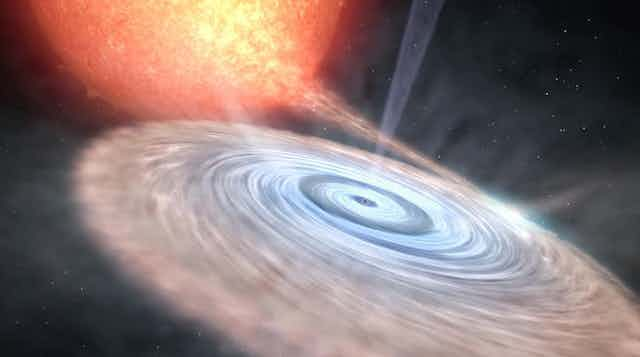Modern science is more about patience and persistence than about great epiphanies. It is therefore extremely satisfying when you make a breakthrough, as it means a lot of hard work has finally paid off. After monitoring a fairly quiet black hole for nearly 26 years, my colleagues and I were thrilled to suddenly catch it emit a powerful wind – something we didn’t even know black holes could do.
We first discovered the black hole back in 1990, when I was based at an observatory on La Palma in the Canary Islands. Orbiting space missions had just detected a mysterious and very bright new X-ray source in the star constellation Cygnus that had undergone a huge outburst. Our observations revealed that V404 Cygni was a black hole of around ten times the mass of our sun. This was the first object in our galaxy to be unequivocally identified as a black hole.

The black hole is part of a binary system – it has a low-mass companion star (only about half the mass of our sun) that orbits around the black hole every 6.5 days. During this process it continuously swallows material from the star. The matter falling towards the black hole forms a so-called accretion disc. Its hotter, innermost zones emit X-rays, which we cannot detect from the Earth’s surface, as they are absorbed by our atmosphere, and hence must be studied from space. The outer regions of the disc, however, emit visible light, which means we can observe this region from the ground.
What makes V404 Cygni special is that, at only 8,000 light years away, it is one of the closest known black holes to the Earth, and has a particularly large accretion disc (with a radius of about 10m kilometres), which makes its outbursts extremely bright. X-ray outbursts from black holes are rare (V404 Cygni is one of the best known), typically happening on timescales of decades. They happen when so much material is accumulated in the accretion disc that it becomes unstable and the disc suddenly starts dumping matter onto the black hole. This causes the matter to reach very high velocities and temperatures, emitting huge quantities of X-rays in the process, at which point they are spotted by orbiting X-ray satellites.
We continued to study the black hole for 25 years, but it was very quiet for most of the time. Luckily I happened to be observing it on June 14 2015, just 13 hours before its next outburst happened, and noticed the accretion disc was moving in towards the black hole. This beautifully illuminates the physics of accretion discs going into an “active” state, so I knew what was coming. Once the outburst began, an international team of astrophysicists was assembled to follow it in detail, using telescopes available to us now of vastly greater power compared to what we were using 25 years ago. This time, its X-ray brightness increased a million fold in a few days, becoming the brightest source in the sky.
Rare glimpse
The results, which have just been published in Nature, are surprising. They show a powerful wind of hydrogen and helium emanating from the black hole and travelling at a mind-boggling speed of 3,000 kilometres a second. Formed in the outer layers of the accretion disc, this wind has to move quickly to be able to escape from the immense gravitational field surrounding the black hole.
The wind is likely driven by the X-rays created in the outburst heating the disc surface to high enough temperatures to escape the disc’s gravity and flow outwards. It is thanks to the high resolution provided by the CANARIAS telescope’s huge aperture that we were able to link this wind with the X-ray flare. And while radio jets accelerated by processes around the black hole itself have been seen in these X-ray outbursts before (including V404 Cyg), this was the first time we had seen a strong wind blown off the outer accretion disc.
The finding allows us to explain why the outburst was so brief, lasting only two weeks, compared to the previous outburst which lasted three months and helped us discover the object in the first place. This is linked to how and at what rate black holes accrete material, and grow in size (mass) – important parameters for understanding the evolution of black holes on all scales in the universe. If this material had not been “blown away”, it is likely that the outburst would have lasted much longer.
It may sound counter-intuitive, but we have known for many years that, in spite of the intense gravitational field close to the Event Horizon of the black hole (within which nothing can escape), the enormous pressure of radiation itself, combined with the spin and magnetic field of the black hole, can lead to large fractions of the infalling matter being spat out – often at velocities approaching the speed of light.
Once the outburst had finished, we were able to detect a nebula – a cloud of dust and gases – formed from material expelled by the wind. This phenomenon also helps us to estimate how much mass was ejected through the wind.
These observations are just a small part of the huge dataset collected worldwide during the outburst, and much more remains to be done as it is all thoroughly digested. But it demonstrates the importance of reacting quickly to these events with our most powerful telescopes in order to catch these events. We are now organising to put programmes in place for future events, as the detailed physics of how black holes suck in matter is still very poorly understood.

